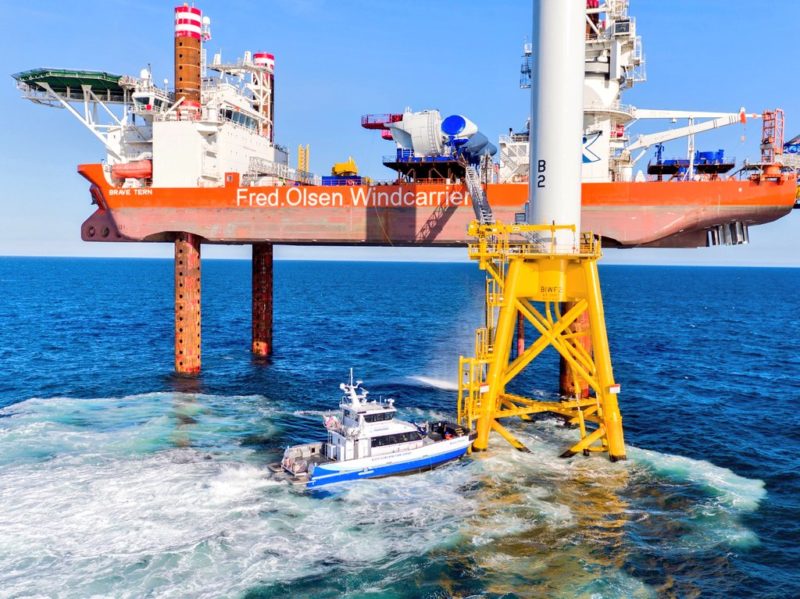Two new plans for offshore wind power could mark the first time a U.S. electric utility ventures into the Atlantic, and the first wind farm that would be linked to onshore battery storage.
Dominion Energy Virginia announced July 10 it had signed a partnership with Danish wind energy developer DONG Energy to build a pair of 6-megawatt turbines 27 miles off Virginia Beach, Va.
With engineering and development work to start immediately, construction could begin by late 2020, according to Dominion Energy. The two turbines on a 2,135-acre site leased by the Virginia Department of Mines, Minerals and Energy would be a first step toward large-scale development on an adjacent 112,800 acres site leased by Dominion Energy from the Bureau of Ocean Energy Management.
Full development could potentially generate up to 2,000 MWs, enough to power 500,000 homes in Dominion’s Virginia and North Carolina service areas, the company said. It would be the second offshore wind energy project in the nation, and the first owned by an electric utility company.
Rhode Island-based Deepwater Wind, the owner of that first 30 MW offshore wind farm at Block Island, made a new pitch Monday to Massachusetts state officials, proposing a 144 MW wind farm 12 miles south of Martha’s Vineyard, linked to an onshore 40 MW battery storage system to be supplied by Tesla.
Dubbed Revolution Wind by Deepwater, the proposal was submitted in response to a Massachusetts request for proposals on new clean-energy sources, and the company also offered alternative bids for a larger 288 MW plan and smaller 96 MW version.
Deepwater won deep political support from Rhode Island for its pioneering project, and wind energy skeptics point to the state’s big rate subsidy that made the project happen. In Massachusetts, Deepwater and its CEO Jeff Grybowski are going up against other green power generators like solar and hydropower, and must show their proposal is competitive.
“Revolution Wind is flexible and scalable. That’s a serious advantage of offshore wind — we can build to the exact size utilities need,” Grybowski said in announcing the bid. “We can build a larger project if other New England states want to participate now or we can start smaller to fit into the region’s near-term energy gaps. And our pricing at any size will be very competitive with the alternatives.”
Deepwater offers another incentive: basing its operations in New Bedford, Mass. The storied fishing port has suffered for years from declining catch limits on cod and other species, and city and state officials had hoped the port could become a base for the long-stalled Cape Wind energy project proposed for Nantucket Sound.
Deepwater and other offshore developers still face resistance from commercial fishermen, but with the federal leases over the horizon and out of sight from land there is not the huge opposition and court challenges that Cape Wind encountered. Deepwater says it will locate final turbine assembly and staging operations at the New Bedford Marine Commerce Terminal, and have its long-term operations and maintenance center for the Revolution project in the city.
With battery storage on shore, Deepwater says it can “help to defer the need to construct costly new peaking generating facilities and controversial transmission lines.” At 144 MW the project could be built during 2022 in a single construction season, lead the way toward larger projects, and help develop and mature a regional supply chain, the company says.
That prospect of new jobs and business opportunities was a driver in Rhode Island support — where Deepwater bases operations out of a Narragansett Bay terminal, and the first U.S-flag wind farm crew boat was built by Blount Boats in Warren, R.I.
Mid-Atlantic states are looking for the same.
“Today marks the first step in what I expect to be the deployment of hundreds of wind turbines off Virginia's coast that will further diversify our energy production portfolio, create thousands of jobs, and reduce carbon emissions in the Commonwealth,” Virginia Gov. Terry McAuliffe said when Dominion Energy announced its plan. “Hampton Roads has the ideal port assets and talented workforce to attract and house the offshore wind business supply chain to support not only Virginia's commercial wind area, but also wind farms under development in Massachusetts, New York, and Maryland.”
Maryland too is hoping to grow a supply industry and jobs out of plans by Deepwater and U.S. Wind to develop federal leases there, and base there construction and operations out of Baltimore.
One wild card: the Trump administration.
President Trump has criticized wind power, and tangled with the government of Scotland over an offshore turbine project that would be visible from one of his golf courses. But the administration has yet to make an overt move against offshore wind project permitting, and developers like Deepwater and DONG are looking at construction timelines that would not start until after a first Trump term.
With deep-red states like Texas and Iowa already invested in wind power, its jobs, and the revenue it brings to farmers and landowners, the industry may get more support in Congress.
One bipartisan bill, introduced by Sen. Tom Carver, D-Del., and Sen. Susan Collins, R-Maine, would extend a 30% federal investment tax credit for offshore turbine projects that currently will expire at the end of 2019. That could boost the long-term prospects for developing large-scale wind farms from Massachusetts to Virginia in the 2020s.





